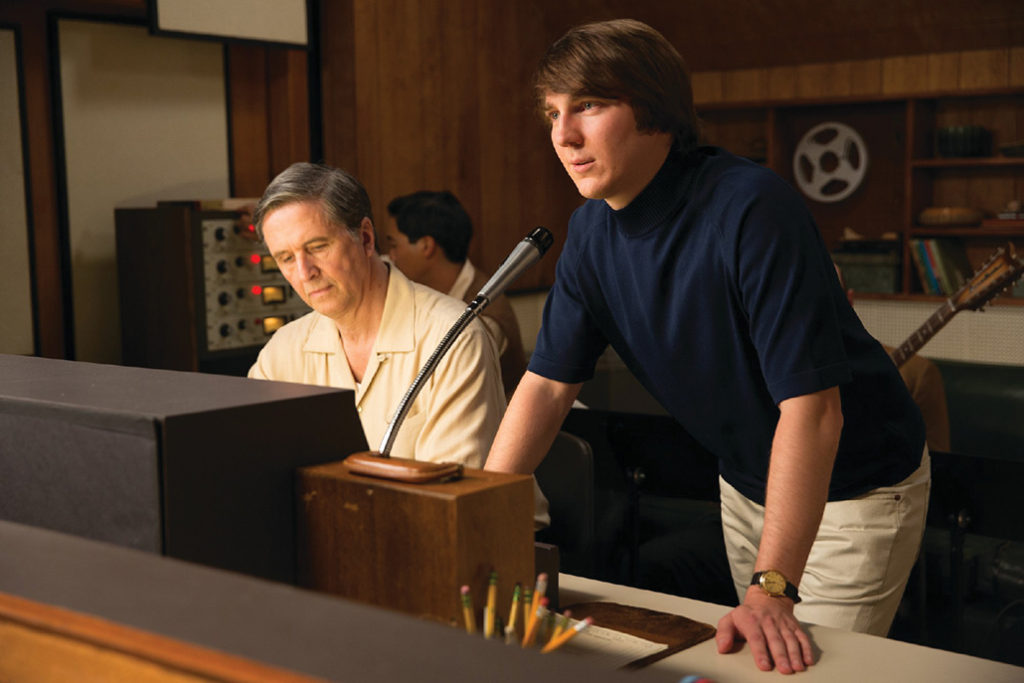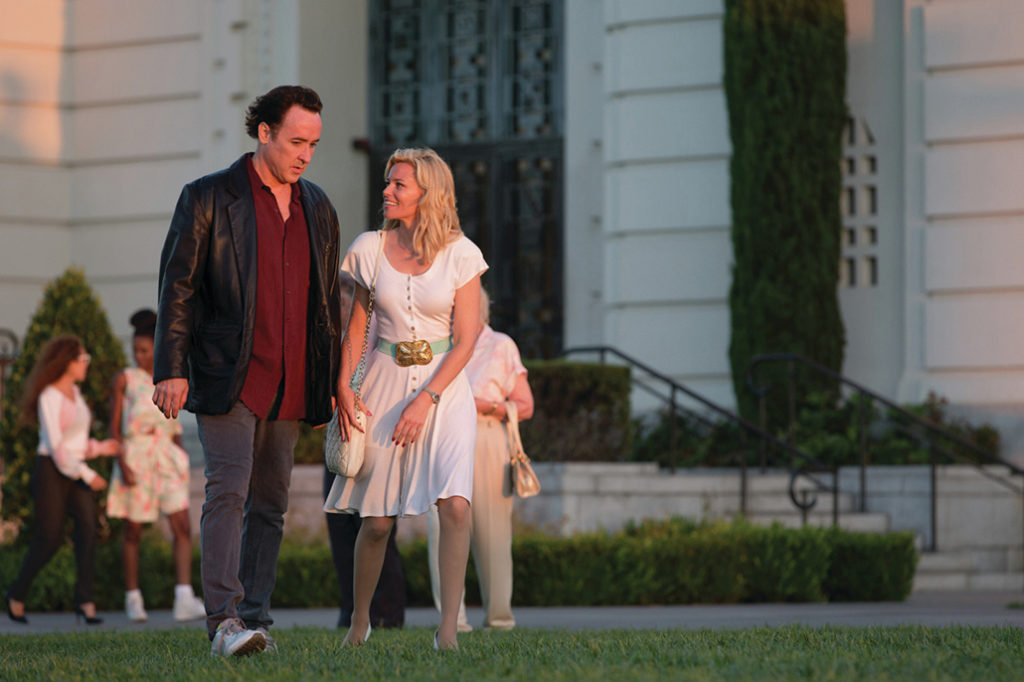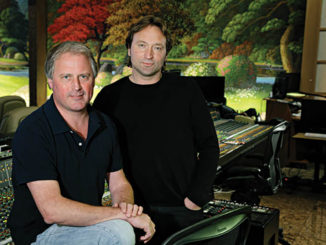
by Debra Kaufman • portraits by Clay Enos
“Surfin’ USA,”“California Girls,” “Good Vibrations”… These and many other Beach Boys songs were the soundtrack to 1960s Southern California’s beach and teen culture. The group that formed in Hawthorne in 1961 was composed originally of three brothers — Brian, Dennis and Carl Wilson — their cousin Mike Love and friend Al Jardine. Their emphasis on vocal harmonies and lyrics about surfing, sunshine, cars and girls quickly caught on, first locally, then nationally and eventually internationally.
Although the Beach Boys achieved the status of one of the best-selling and most critically acclaimed US rock bands of all times, their story had a darker edge, particularly with regard to songwriter and de facto leader Brian, who struggled with mental illness and substance abuse.
The new biopic Love & Mercy, in theatres June 5 through Roadside Attractions, tells the story of Brian Wilson (Paul Dano and John Cusack) at two crucial points in his life: in the 1960s, as he’s creating the critically acclaimed album Pet Sounds and beginning to hear voices in his head, and in the 1980s, when he is under the care of controversial psychotherapist Dr. Eugene Landy (Paul Giamatti), and meets future wife Melinda Ledbetter (Elizabeth Banks), who fights for Brian’s well-being. The independent movie is also infused with the iconic sounds of the 1960s group and shows the in-studio process featuring the storied session musicians known as the Wrecking Crew.
Directed by Bill Pohlad, who has spent the majority of his career as a producer (12 Years a Slave, The Tree of Life), Love & Mercy features a stellar behind-the-scenes crew, including cinematographer Robert Yeoman, ASC (Budapest Hotel, Moonrise Kingdom); composer Atticus Ross (Gone Girl, The Social Network); editor Dino Jonsäter (Tinker Tailor Soldier Spy) and supervising sound editor and music editor Nicholas Renbeck (Marley & Me, Rachel Getting Married).Renbeck studied film at Ithaca College, where one day a guest speaker came to his class: Ron Bochar, an Ithaca alumnus who had just co-founded C5 Audio in New York. He brought in a three-quarter-inch videotape of C5’s work on Silence of the Lambs. By the time the tape was over, Renbeck was hooked on sound editing.

After persistent inquiries, he got his first job at C5 Sound as an apprentice sound editor on Jonathan Demme’s Philadelphia in 1993. As the features from the Coen Brothers, John Sayles, Mike Nichols, Martin Scorsese and many other directorial greats came through the sound facility, Renbeck continued to learn from every editor he worked with. He was promoted to editor in 1997 on Scorsese’s Kundun, “a great first movie to cut my teeth on,” he says. Love & Mercycame to Renbeck when
Pohlad decided to do his post-production in New York. Producer Ann Ruark and post-production supervisor Gerry Byrne had both been in contact with Paul Hsu and Phil Stockton at C5 Sound, who had recommended Renbeck and sound designer Eugene Gearty, MPSE. The two met with Pohlad, Jonsäter and Byrne; Renbeck’s interest was piqued by the fact that Ross was the composer and Chris Jenkins would be the re-recording mixer.
“Bill definitely had a vision of how he wanted the film to sound,” Renbeck says. “In the 1960s part of the story, we are focused on what Brian Wilson is going through both creatively and emotionally. As he begins to break down, Bill had us explore ways in which we could get more into Brian’s head sonically though sound and music.”
An example of that comes early in the film when Brian, travelling with the other Beach Boys, has a panic attack on an airplane. “Bill had us keep raising up the sound of the airplane and bringing down the voice of Brian’s brothers as they try to help him until they cannot be heard at all,” says Renbeck. “All that’s left is just the overwhelming plane sound.Very simple, but very effective.”
In the 1980s segments, Brian’s life is shown mostly from the view point of Melinda, a calming influence on him. “The music and sound plays more straight during these scenes,” says Renbeck. “It’s only when Dr. Landy’s or Brian’s actions alarm her that we change the dynamic sonically.”
When Renbeck began work on Love & Mercy, the deadline for the temp was looming, and there was no music editor. “Unfortunately, we found out we were not going to be able to have Chris Jenkins on the temp,” recalls Renbeck. “It was a tight schedule, and since it was Eugene and me at that point, we both said, ‘Okay, let’s just do it ourselves.’ C5 has three modest-sized 5.1 Dolby-approved design/mixing rooms, each with a ProTools HDX2 set-up, and we ended up doing the temp there. I think we both just hunkered down, prepped our tracks, pre-mixing as we went.”

Gearty handled the sound effects and Foley and Renbeck worked on the production tracks and all currently existing music. “Atticus had sent over a number of stereo mix-downs of his cues,” Renbeck relates. “As we got closer to the temp, he got me some of his full stem mixes. It was a few very busy — yet really fun — days. It turned out to be a great shakeout to see and hear what was what. It allowed Bill, Dino, Eugene and me to get to know each other’s sensibilities, and I started figuring out a number of music challenges the film presented.
“Atticus is very exact in his tracks and gives fantastic music stems to the mixer that are really ready to go,” continues Renbeck. By the time he was finished with that first temp, “I figured I’ll officially be the music editor; I’ll own the music at this point.”
But Renbeck never lost sight of the fact that Jenkins would be stepping in. “The temp played and looked good,” he says. “I really started to like the way some of the production music into Beach Boys music transitions were working. And once Chris joined us, I knew the whole film was only going to get even better. But in turning the mix over to Chris, I wanted to make sure I didn’t tie his hands with any of the decisions I made in the temp. You don’t want to put the mixer in a position where he can’t do what he needs to do because the editor has made those decisions for him. I was really concerned that I figure out a way to deliver to him what I’d done, but in a manner that allowed him full control.”
The solution was a handful of conversations between Renbeck and Jenkins, in which they figured out a template of how to work. With dialogue and ADR, they brought it back to a more traditional turnover. “But with the music elements, where I’d done a lot of mixing, panning, adding reverb and figuring out transitions from actor to Beach Boys or, say, placement of the Wrecking Crew within the studio, we let that live within ProTools,” he explains. “If needed, we could break those elements back out and put them in a standard turnover to him. But if it works as I prepped them, we would just keep it that way. Then Chris and I could work together at the final to further fine-tune those spots.
The first temp was the most challengingpart of the process. When it became clear that Renbeck would be doing the music editing as well as supervising sound, ADR editor Ruth Fernandez stepped in to do some of the dialogue editing for the later reels. “She and I were talking throughout the entire process, so it was a nice, natural way to make that work,” says Renbeck. “I’d cut the first few reels of dialogue and then she picked up the last couple, although I hung on to the music-based sections.”
“We are focused on what Brian Wilson is going through both creatively and emotionally… Bill [Pohlad] had us explore ways in which we could get more into Brian’s head sonically though sound and music.” – Nicholas Renbeck
Renbeck tips his hat to assistant sound editor Sam Miille, who has worked closely with Gearty for several years. “Sam kept everything running so well,” says Renbeck. “I think a good assistant sound editor is often the key to a smoothly running post sound job. Sam was on top of everything, which allowed me to think much more on the actual editing end of things.” He also credits Steven Visscher’s Foley supervision, Foley artist Marko Costanzo and Foley recorder George Lara. One of the biggest challenges was figuring out how to transition from actor Dano’s singing into the actual Brian Wilson track. “Paul is a capable singer so I had a great starting point,” says Renbeck. “That was a major advantage when working to figure out how to make the change from actor to actual Beach Boy or how to handle hearing both Paul’s and Brian’s voices at the same time.” Early on, Pohlad, Jenkins and Renbeck talked about what they should be aiming for during the scenes where they are recording music or singing for what would ultimately become Pet Sounds.
“To try and make Paul sound exactly like Brian wouldn’t really make sense,” says Renbeck. “Bill’s feeling was that this is the process of making Pet Sounds. We are hearing Paul [as Brian] figuring it out. For the scene where Brian and the Beach Boys lay down the vocals for ‘You Still Believe in Me,’ it gave me the freedom to start with Paul singing, then cross into Brian just as all the Beach Boys singing harmony begins. And then when we return to just Brian, we hear the actual Brian.”
Renbeck got “a little help” using DUY’s Magic Spectrum (sampling Brian’s singing and applying it to Paul) and using Waves Tune on a couple of words. “I was able to bring his vocals to a pretty good match,” he says. “On the original vocal stems of many of the Beach Boys tracks, there is already a great lush reverb mixed in. It took a little while and a couple of happy accidents until I found a nice match. In the end, I think we get a scene where we again see Brian [Paul] trying to find his voice as he begins to sing the song, then hits his stride as his fellow Beach Boys join him.”
Jenkins, Gearty and Renbeck figured out how they wanted to treat the aural space of the recording studios (against that of the control room), and what it would sound like behind the glass. “When the camera does a 360-degree turn all around the studio while the musicians practice and gear is moved around, thanks to [location sound mixer] Edward Tise’s production recording, we were able to move everybody around to match the camera move,” says Renbeck. “Edward gaveus remarkable coverage, including many separate mics which worked very well in the scene with the Wrecking Crew, or the Beach Boys in the recording studios.We were really able to spread out the actors/musicians in the recording studios and give them a space with lots of activity going on, not just on the screen, but in the surrounds as Brian moves through the room.”

Renbeck found Ross’ music fun to work with.“The way he incorporated so many samples of so many Beach Boys songs into his score was impressive,” he says. “His score gives us another way to experience the Beach Boys; the tracks were very well thought out with separation in his stems, which allowed us to make the most of the 7.1 mix.”
Working on The Beach Boy tracks was a “chance to pull back the curtain a bit and see exactly what was happening,” says Renbeck. “We were able to have access to some of the stems of a number of the songs featured in the film,” he says. “There’s a great track from the recording of ‘Good Vibrations’ where Brian is talking from the booth, giving the band directions on how he wants them to play something.They do a pass, he gives them feedback, and they do it again. Then Brian starts plugging and unplugging a piece of gear that theaudio is running through, causing the whole track to jump up in volume in kind of a startling way.
When it came to the soundscape, Love & Mercy is, in many ways, “a quiet walk-and-talk film in terms of sound effects” — but not always. “Eugene was spot on with everything he brought in terms of sound effects and backgrounds,” says Renbeck. “There are some moments that are full on; such as his design work during the underwater pool scene where Brian is hearing voices ping-ponging around with reverbs and delays that work fantastically with Atticus’ music. And then the Foley he mixed along with his sound design in the quiet scenes is just right.”
Dialogue pre-dubs and the final-mix were done at Harbor Sound on two Avid System 5 consoles,” Renbeck reports. “Eugene handled the sound effects and Foley, and Chris handled the dialogue, ADR and music. Ian Gaffney-Rosenfeld was our assistant re-recorder mix tech; he did a good job of knowing what we needed to keep the stage rolling.
“And I’m the lucky guy who puts it all together,” Renbeck concludes. “I am fortunate to be a part of this great crew.”






